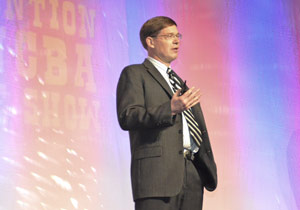CattleFax Market Outlook
Analyst looks at cattle numbers, offers market outlook.
by Troy Smith for Angus Productions Inc.
NASHVILLE, Tenn. (Feb. 3, 2012) — Kevin Good is optimistic about cattle prices for 2012. The market analyst talked about cattle numbers, meat production and price-influencing trends during the CattleFax Outlook Seminar held in conjunction with the 2012 Cattle Industry Convention in Nashville, Tenn. Good also predicted a transition to gradual expansion of the U.S. cow herd, bringing an end to the long-lasting liquidation phase.
The beef cow count continued its decline in 2011, dropping a million head. However, Good said liquidation is slowing and numbers should stabilize. This year, cow slaughter is expected to decline by 600,000 head. It should decline further in 2013. Heifer retention has modestly increased among Northern Plains producers, and Good said he expects a more generalized trend in 2012 and 2013.
“Cattle-on-feed numbers are up, driven by early placement of Southern Plains calves, but we foresee lower placements ahead,” reported Good.

Kevin Good Photo by Kasey Miller
In 2012, CattleFax looks for steer and heifer slaughter to be down 1.5% (around 400,000 head) due to a smaller calf crop and the start of heifer retention. Beef production in 2011 was about even with the previous year, but 2012 production is projected to be down 1.5% due to reduced total cattle slaughter. Cattle are being fed to heavier weights, and Good said he expects 2012 carcass weights to increase by 11 pounds (lb.), on average. The increase is not expected to offset the effect of lower slaughter numbers.
According to Good, 550-pound (lb.) steer calf prices should average $175 per hundredweight (cwt.) in 2012. That’s 15%-18% higher than last year’s average. Yearling (750-lb.) steers are expected to trade at $150, or 15% over the 2011 average. Fed-cattle prices should average $122. The price spread between Choice and Select carcasses is predicted to remain wider than during the last few years.
“High calf prices should more than offset higher input costs, so the outlook is very positive for cow-calf producers,” said Good.
However, he said stocker operator margins may be squeezed by those high calf prices and increased pasture costs. He said he expects feedlot margins to be negative for the year, making risk management a necessity.
According to Good, smaller calf crops, reduced cow slaughter and increased heifer retention will result in significantly fewer cattle to place on feed and fewer fed cattle to process. This may force the beef industry to deal with the issues of excess feeding and packing capacity.
-----------------------------
Editor’s Note: The above article was written under contract or by staff of Angus Productions Inc. (API). It may not be reprinted without express permission of API. To request reprint permision, contact the editor at 816-383-5200.
www.4cattlemen.com is an event coverage site provided by the editorial team at Angus Productions Inc. (API), publisher of the Angus Journal, the Angus Beef Bulletin, the Angus Beef Bulletin EXTRA and the Angus e-List. For questions about this site, to submit an article for our consideration, or to report a broken link, contact the editor at 816-383-5200; 3201 Frederick Ave., Saint Joseph, MO 64506.
API claims copyright to this web site as presented. We welcome educational venues and cattlemen to link to this site as a service to their audience.

